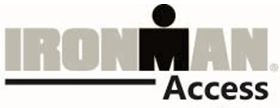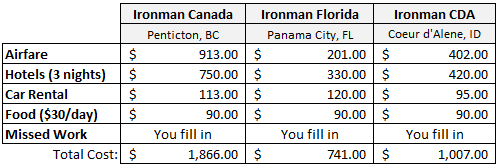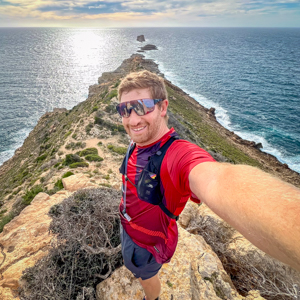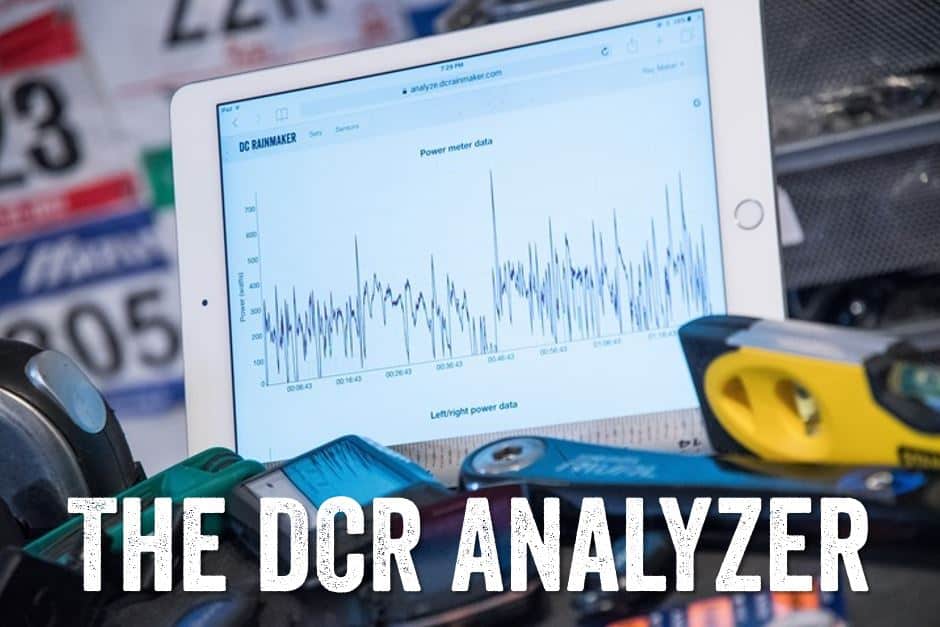 For most that saw World Triathlon Corporations (WTC) e-mail announcement on Wednesday, or heard about it online, the initial reaction tended to be of anger – if not outright disgust. However, the more I dug into responses from folks on forums, or the slew of e-mail I received about it, it was interesting to note a bit of a second thoughts on the part of many.
For most that saw World Triathlon Corporations (WTC) e-mail announcement on Wednesday, or heard about it online, the initial reaction tended to be of anger – if not outright disgust. However, the more I dug into responses from folks on forums, or the slew of e-mail I received about it, it was interesting to note a bit of a second thoughts on the part of many.
A second glance you ask? Yes, looking at the e-mail again and wondering – would this make sense? No, not would it make sense from WTC’s standpoint (that’s an obvious yes), but rather – would it make sense for an athlete? As a athlete looking to race an Ironman, in what circumstances might this actually work out to pay the $1,000 for guaranteed entry into virtually all of the non-qualification Ironman races (everything but Kona basically).
Before we dig into that, let’s take a quick look at the official benefits list:
• $1000.00 USD for a one-year membership
• Exclusive advance registration to Ironman events
• Two VIP passes per registered event
• Official membership ID card
• Second chance in the Ironman Lottery Program*
• One-year subscription to LAVA Magazine
• Discounts on Ironman partner products at shopironman.com and on-site event retail stores
• 2010 Ford Ironman World Championship NBC broadcast DVD
• The above benefits are valid for one year starting from activation date
Now clearly, the most valuable thing listed here is the ‘Official membership ID card’ – as without it, my life would likely not be complete. Clearly I’d never carry such a valuable card in my wallet, but rather frame it – like presidential signature. Ok…just kidding…maybe.
Outside the obvious advanced registration (the main reason to get Ironman Access), you get Two VIP passes per event, I’d assume that’s simply access to the finishers area, and better grandstand seating (not really needed honestly). You get a subscription to Lava, and an undetermined discount to ShopIronman.com, along with a DVD of a show you can get for free on TV in December on NBC. Finally, you get two entries into the Ironman Kona lottery (instead of one).
In short, aside from the early entry, I don’t see any real tangible or substantial benefits there that make me say “Booyeah baby!”. I’ll talk a bit later on what they could have done to sweeten the pot.
Also – I want to make sure everyone is clear before I really get cookin’ – this does NOT include your $550 entry fee. That is separate, and in addition to the $1,000 Ironman Access.
So now that we’ve identified what’s part of the program, you start to do a bit of math in your head. After all, for all of the North American Ironman races, you’re required to register onsite the day following the race, one year prior. In other words – to register for the July 2012 Ironman Lake Placid, you have to be onsite at Lake Placid on the Monday following the July 2011 Ironman Lake Placid.
Sure, there are usually a handful of regular slots available a few weeks later online – but those are fairly hard to get and there’s no guarantees they’ll even be made available at all. Hardly something you’d want to bet your season on.
Cost & Benefits Comparison: Travelling to a race to pre-register
Given the travel and time costs associated with going to the race site a year prior to register, one starts to ‘glance back’ at the Ironman Access e-mail that you might of so quickly put into the Deleted Items bin and wonder – does it make sense?
And it’s that “hmm factor” that had me starting to do some math. Now, I’ll talk about the whole ‘Ironman Spirit’ thing in a second, for now – let’s just play a numbers game.
I assumed three different races, all travelling from Washington DC. As always with airfares, some will be higher, and some lower. I simply chose the cheapest flights I could find using a quick Expedia search. I assumed departure on Friday evening, and returning mid-day Monday. You can’t leave the site any early than late-morning Monday (as registration typically doesn’t open up until between 7AM and 9AM). And Friday evening seemed normal for most folks wanting to go and enjoy the weekend a bit. Sure, you could fly in Sunday and out Monday – but I don’t think most folks will do that.
Here’s the details:

(Flights from WAS to Penticton, Panama City, Spokane)
Note on the hotel front – I used realistic rates for the Ironman event time period. Hotels in Penticton may be $80 a night the rest of the year, but come Ironman week you won’t find anything less than $250 a night (if at all). Meanwhile…you can easily find super chea places in Panama City that time of year, like I did for IMFL last year.
As you’ll note, in the case of Ironman Canada and Ironman CDA, you’re spending at least $1,000. And I think most folks can agree I was pretty generous with being uber-cheap. I choose some of the cheapest hotels (as sketchy as it may be), along with the absolute cheapest car. And, you’re only getting $30 a day to eat ($10 a meal). You could swap out the rental car for a taxi – but you’ll be hard pressed to spend less than that in total on taxi fares. And in the case of Penticton you could fly to Vancouver and drive – but that increases your time commitment a fair bit.
Of course, that’s not even including any missed work. I left that part blank, since it will vary radically from person to person.
Now, as you probably noticed, for some events you can get away pretty cheap – and IMFL is a prime example of that. Due to the low cost nature of the area, both airfare and hotels are incredibly inexpensive there, thus IMFL is a great example of an event where it makes more financial sense to go down to and register in person (plus, it’s WAAAY more fun). And there’s a beach. And sand. And pretty blue water.
Cost & Benefits Comparison: Ironman Charity Slot
Now, the Ironman Access program isn’t the only way to get a slot without showing up at the race site. The most well known way is actually to take advantage of the Ironman Foundation Community Fund slots. These slots cost twice as much as the regular entry fee, but the ‘profit’ over the base entry fee is donated to charities in the local community – hence the ‘Community Fund’ part.
The Community Fund slots cost $1,150US – and are typically available shortly after race day registration has closed. Given a normal Ironman entry fee is $575US, this means you’re paying an additional $575US for the guaranteed entry into the otherwise sold out event. However, all of that ‘additional cost’ is actually considered a tax deductible donation – thus, assuming a 30% tax deduction, you’re really looking at about $400 more than the cost of regular entry. Plus…it all benefits charity.
Now – it’s important to point out this is substantially different from a timing standpoint than the Ironman Access program. The access program aims to guarantee you a slot PRIOR to regular entry day (upwards of some 24 months out), whereas the Community Fund slots aim to guarantee you a slot AFTER regular entry has sold out. Also, keep in mind sometimes those slots go quickly – for example, IMLP slots for next year are already sold out.
Cost & Benefits Comparison: Volunteering and/or cheering
It should be pointed out that one avenue for picking up an entry to a race is to volunteer at said race. I wanted to mention this for a few reasons: 1) Because some folks might not realize it and 2) Because it’s a very valid way to guarantee entry.
However, in the context of the financial argument the volunteering aspect is really a zero-sum game. Either you’re a local – in which case none of this really applies because you can just go there on race morning for relatively nothing. Or you’re an out of towner, which means all of the above travel and expenses still apply. WTC doesn’t pay its volunteers for time or expenses (despite being a for-profit company), so you’re still going to incur all of the costs above.
Of course, any Ironman finisher or supporter will tell you that volunteers are an integral part of the overall Ironman day – so I don’t want to discount the value of that at all. And the same goes for spectators and fans out there – including those specifically there to register the following day. As some of you may remember, for my first Ironman I went up to Penticton the day prior and enjoyed the later portion of the race (that was ironically my very first post). And nothing compares to the Ironman finish line at midnight, especially as a motivator for the following year.
In addition, the benefits for an athlete to be able to see (and possibly even train) at the race area a year prior to the race can’t be overstated. For me, being able to get a mental image of the race course and my surroundings a year prior was invaluable to knowing what I’d be going into.
Impact on regular registration
There’s some concern that the Ironman Access program will cause sellouts at events onsite, thus limiting folks who travel to the event to be able to signup. I honestly don’t foresee this occurring. I would wager that the people who take advantage of the Ironman Access program are the same people that probably would have travelled to the event anyway. Further, I think that in the scheme of 3,000+ participants per event, this will statistically be a very small percentage. And keep in mind – 3,000 is the number that show up on race day – not necessarily the number of registration (always higher to account for no-shows).
Also, I don’t think this will lead to any people being turned away from registration on the day after. Ironman (to my knowledge) has never turned away folks standing in line to register – it’s always been a ‘everyone in line gets in’ sort of situation.
Now none of this discounts the fact that this is a money grab from WTC. It doesn’t change the fact that it has upset many. And it doesn’t change the fact that we’re seeing a very swift shift over the past few months in the way WTC is looking to monetize the Ironman brand.
But I only foresee further changes like this in the future.
I’m honestly a bit surprised that the Ironman Access program wasn’t more far reaching than it is. I would have loved to see something similar to the Ironman Pro program which allows professional athletes to sign-up for a number of Ironman events at a set price. Now I don’t want to see that at the Ironman 140.6 level for AG’ers, but rather at the 70.3 level for AG’ers. Again, I think the Ironman Access program is just the start.
But finally, keep in mind that Ironman isn’t the only game in town. There are tons of great independent iron-distance races out there – you may remember my post on comparing iron-distance to Ironman races back a bit ago. I do however think you’ll see that these sorts of moves only serve to escalate the growing competition between Rev3 and WTC…which, in my opinion – is great for the sport, even if the means (Ironman Access), are questionable.
FOUND THIS POST USEFUL? SUPPORT THE SITE!
Hopefully, you found this post useful. The website is really a labor of love, so please consider becoming a DC RAINMAKER Supporter. This gets you an ad-free experience, and access to our (mostly) bi-monthly behind-the-scenes video series of “Shed Talkin’”.
Support DCRainMaker - Shop on Amazon
Otherwise, perhaps consider using the below link if shopping on Amazon. As an Amazon Associate, I earn from qualifying purchases. It doesn’t cost you anything extra, but your purchases help support this website a lot. It could simply be buying toilet paper, or this pizza oven we use and love.


















